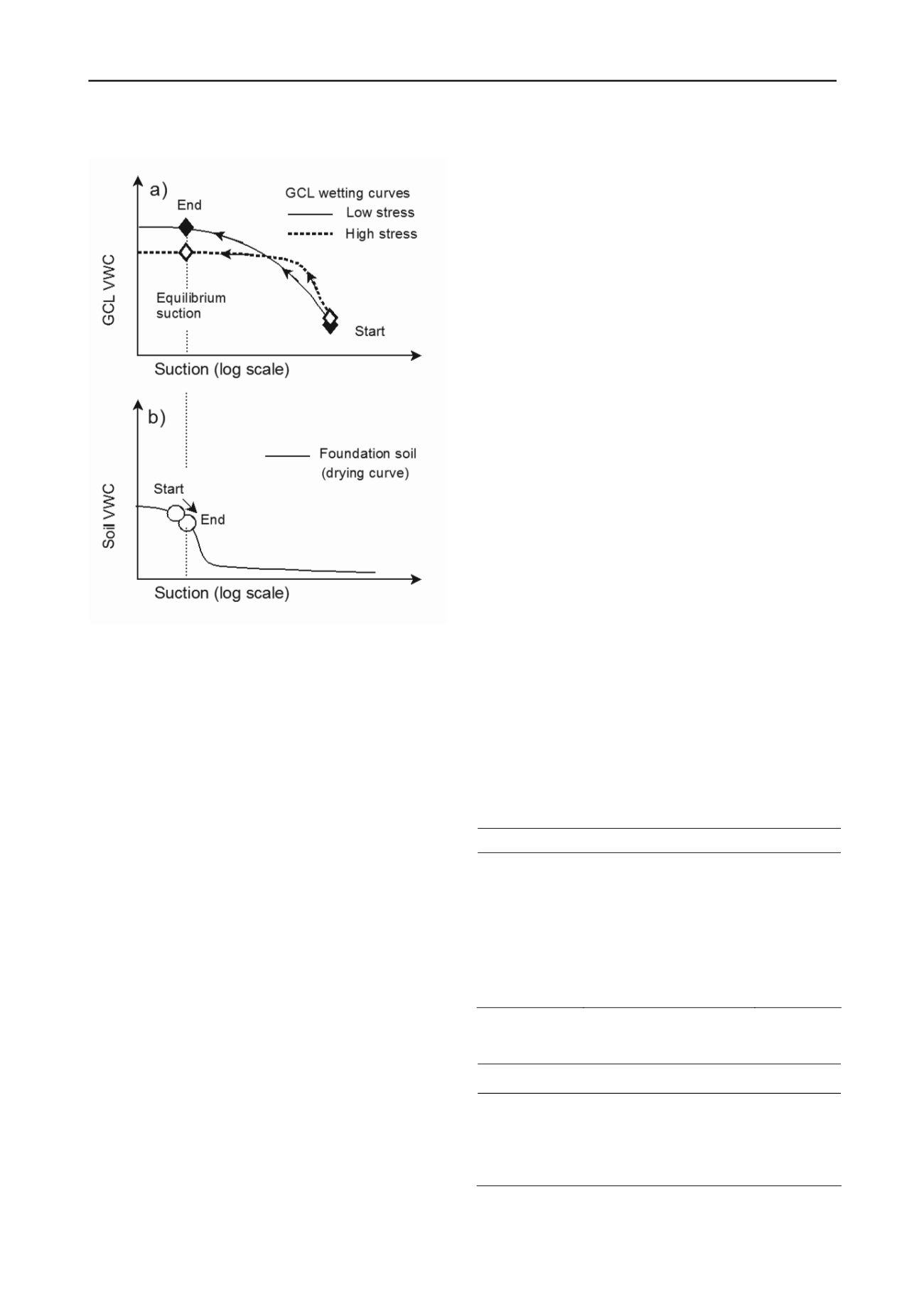
1188
Proceedings of the 18
th
International Conference on Soil Mechanics and Geotechnical Engineering, Paris 2013
Figure 1. Unsaturated paths followed during closed hydration of a GCL
placed on a foundation soil.
Although it is possible for hydration to occur under the
conditions previously described, it is also possible that GCL
hydration may occur later in time after construction when it is
subjected to the higher confining stress associated with waste
placement. Based on the effect of higher normal stress on other
geomaterials (e.g., Fredlund and Pham 2006) it is hypothesised
that confining stress will have a similarly significant impact on
the WRC of the GCL and its hydration behaviour. In particular,
the increased confining stress will reduce the height of the GCL
after it is fully swollen to its saturated moisture content when
compared to a similar GCL at a nominal 2 kPa confining stress
(Figure 1). A GCL hydrated at high confining stress will
therefore have a lower void ratio than a GCL hydrated at low
confining stress. This change in the pore structure of the
encased bentonite of the more confined GCL will result in a
reduction in the GCLs saturated conductivity and an increase in
the air entry value of the GCL from the values measured at low
confining stress.
Despite there being clear indications that confining stress will
significantly impact the WRCs of GCLs, there is currently a
paucity of WRC data for GCLs at higher confining stresses (the
one exception being the two GCL specimens tested by Southen
and Rowe, 2007). As a result, the practical impact (if any) of
confining stress on the magnitude and rate of hydration is not
immediately clear. However, data exists that describes the water
retention behaviour of GCLs at low confining stress, and the
consolidation behaviour of saturated GCLs to confining stress.
In this paper we report a numerical sensitivity analysis to
quantify the potential impact higher normal stress could have on
the rate of hydration of GCLs to assess whether it is likely to
have any practical impact on the hydration behaviour of GCLs
assumed in landfill design.
2 MODEL DESCRIPTION
The effect of confining stress on the moisture uptake of GCLs
was investigated for a typical geotextile-encased GCL
consisting of a woven cover and a non-woven carrier geotextile
with the material properties listed in Table 1. The water
retention behaviour of this GCL has been quantified at a low (2
kPa) confining stress by Beddoe et al. (2011). The WRC
relationship for this GCL and a typical silty-sand foundation
soil are listed in Table 2 and plotted in terms of volumetric
water content against suction in Figure 2.
The material properties for the GCL at high confining stress
(Figure 2 and Table 2) were estimated from experimental
results. Southen and Rowe (2007) reported drying WRCs for
the GCL at 100 kPa vertical stress, which allowed comparison
with the low stress data. Comparing the fitted curves indicated
an increase in the ‘a’ parameter of 100 kPa was necessary to
match the results (Table 2). Beddoe et al. (2011) compared
WRCs of various GCLs and reported that at suction values
greater than approximately 3000 kPa, the WRCs were similar.
Therefore the ‘a’ parameter for the wetting curve was increased
by two orders of magnitude as listed in Table 2. The ‘m’ and
‘n’ parameters were adapted to ensure the WRC agreed with
other GCLs for higher suction values. Lake and Rowe (2000)
reported on the compressibility and swell behaviour of GCLs.
The results were used to estimate the height and saturated
porosity of the hydrated GCL at 100 kPa vertical stress. Finally
conductivity data obtained at various confining stresses (Rowe
and Hosney, 2013) was used to estimate the saturated
conductivity at 100 kPa.
The finite element model (Figure 3) procedure was described in
detail earlier (Siemens et al. 2012) and a brief summary will be
given here. The initial moisture conditions are set in the GCL
and foundation soil and then the model steps forward in time
under closed conditions. As-manufactured the GCL is at
nominal moisture content and approximately 10
5
kPa suction.
The soil is at a suction corresponding to its initial moisture
content. During closed isothermal hydration the foundation soil
undergoes minor drying while the GCL approaches the suction
boundary condition provided by the soil. At equilibrium the
system achieves a hydrostatic state.
Table 1. Properties of GCL1
Property
GCL
Average GCL mass
per unit area (g/m
2
)
Measured
Minimum Acceptable Roll Value
4679
3965
Carrier Geotextile Type
Mass per unit area (g/m
2
)
W
120
Cover Geotextile
Type
Mass per unit area (g/m
2
)
NW
240
Bentonite
Montmorillonite content (%)
As-delivered form
50-55
Fine granular
Structural
Needle-punched
Thermally treated
Yes
Yes
Table 2. GCL and foundation soil Fredlund and Xing fitting parameters
or water retention curves and saturated hydraulic conductivity values.
f
Parameter
GCL
2 kPa
GCL
100 kPa
Soil
Fitting
parameters
a (kPa)
n
m
r
(kPa)
13.10
0.84
0.51
2559
1310
3.20
0.32
2559
6.73
1.95
0.78
5856
Saturated VWC
(%)
0.73
0.55
0.39
K
sat
(m/s)
1.5x10
-11
3.5x10
-13
9.5x10
-4


